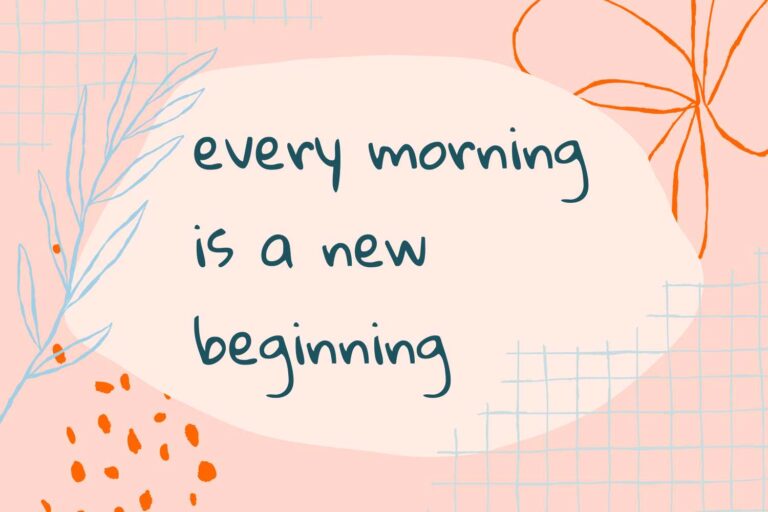The power of affirmations: A complete beginner’s guide
The truth is that most people are doing affirmations completely wrong.
You’ve probably seen the Instagram posts. Someone standing in front of a mirror saying “I am a millionaire” while they can’t pay rent. Or repeating “I am confident” while their hands shake from anxiety. And then wondering why nothing changes.
Here’s the reality – affirmations aren’t magic spells. They’re not going to transform your life just because you say pretty words to yourself in the mirror. But when you understand how they actually work and use them correctly, they become one of the most powerful tools for rewiring your brain and changing your reality.
This isn’t about toxic positivity or pretending your problems don’t exist. This is about using science-backed techniques to literally change the structure of your brain and create lasting transformation.
What affirmations actually are (and what they’re not)
An affirmation is a statement designed to challenge and replace limiting beliefs. It’s not wishful thinking – it’s cognitive restructuring.
Think of your brain like a highway system. Every thought you think creates a thought pattern. The more you think certain thoughts, the more established those pathways become. Eventually, they become superhighways – automatic patterns that your brain defaults to without conscious effort.
If you’ve spent years thinking “I’m not good enough,” that’s a superhighway in your brain. Saying “I am worthy” once isn’t going to create a new route. But saying it consistently, with intention and emotion, starts building that new pathway. Over time, with repetition, that new pathway becomes stronger than the old one.

Why your brain believes what you tell it
Your subconscious mind doesn’t distinguish between what’s real and what’s imagined. This is why athletes use visualization – their brains create the same neural patterns from imagining perfect performance as they do from actually performing perfectly.
When you repeat an affirmation with conviction and emotion, your subconscious begins to accept it as truth. Not because you’re delusional, but because you’re literally creating new neural connections that support this belief.
Studies show that people who practice positive self-affirmations show increased activity in the brain’s reward centers and reduced activity in the areas associated with threat detection. Translation: your brain starts looking for evidence to support your affirmations rather than constantly scanning for danger or failure.
But here’s the catch – and this is where most people mess up – your affirmations have to be believable to your current self. You can’t jump from “I hate myself” to “I’m amazing” without your brain rejecting it completely.
The affirmation reality check: What actually works
What doesn’t work:
- Saying things you don’t believe at all.
- Using affirmations to avoid dealing with real problems.
- Expecting instant results without taking action.
- Generic, cookie-cutter statements that don’t resonate with you.
- Affirmations that focus on what you don’t want.
What works:
- Statements that feel like a stretch but not impossible.
- Affirmations paired with consistent action.
- Personalized statements that address your specific challenges.
- Present-tense language that makes your brain accept it as current reality.
- Positive framing that focuses on what you want to create.

How to create affirmations that your brain will believe
Step 1: Identify your actual limiting beliefs
Before you can replace negative thoughts, you need to know what they are. Most limiting beliefs run on autopilot, so you’ll need to catch them in action.
For one week, pay attention to:
- What you tell yourself when you make mistakes,
- How you talk about your abilities and potential,
- What you assume about how others see you,
- Your automatic thoughts in challenging situations.
Write them down. All of them. Even the ugly ones.
Step 2: Find the bridge belief
Don’t try to jump from “I’m worthless” to “I’m amazing.” Your brain will reject it faster than a bad Tinder date.
Instead, find a bridge belief – something that feels more true than your current belief but isn’t so far-fetched that you can’t accept it.
Instead of: “I am confident in all situations.” Try: “I am learning to trust myself more each day.”
Instead of: “I am wealthy and abundant.” Try: “I am open to receiving opportunities for financial growth.”
Instead of: “I never make mistakes.” Try: “I learn and grow from every experience.”
Step 3: Make it personal and specific
Generic affirmations are like generic advice – technically correct but practically useless. Your affirmations should address your specific challenges and goals.
Vague: “I am successful.” Specific: “I confidently share my ideas in meetings and contribute valuable insights.”
Vague: “I am healthy.” Specific: “I honor my body by making choices that give me energy and strength.”
Vague: “I am loved.” Specific: “I attract relationships with people who appreciate and respect my authentic self.”
Step 4: Add emotional weight
Your brain pays more attention to information that comes with emotion. Dry, robotic affirmations don’t create change. Affirmations that make you feel something do.
When you say your affirmation, connect with:
- How it would feel if this were already true,
- Why this change matters to you,
- What your life would look like with this new belief.
Don’t just say the words. Feel them.

The complete affirmation framework
For building self worth
- I am worthy of love and respect exactly as I am.
- My value doesn’t decrease based on others’ inability to see it.
- I treat myself with the same kindness I show my best friend.
- I deserve to take up space and have my needs met.
For overcoming fear
- I can feel afraid and still take action.
- I trust myself to handle whatever comes my way.
- My courage grows stronger every time I face my fears.
- I choose growth over comfort.
For building confidence
- I believe in my ability to learn and adapt”.
- I trust my judgment and make decisions with confidence.
- I speak up for myself and my ideas matter.
- I am becoming more confident with every challenge I face.
For releasing control
- I control my effort, not the outcome.
- I trust the process even when I can’t see the whole path.
- I release what I cannot control and focus on what I can.
- I am safe even when things don’t go according to plan.
For financial abundance
- I am open to receiving money from multiple sources.
- I make financial decisions from abundance, not fear.
- I deserve to be compensated fairly for the value I provide.
- Money flows to me as I serve others with my gifts.
For health and vitality
- I listen to my body and give it what it needs.
- I make choices that honor my long-term health and happiness.
- My body is strong and capable of amazing things.
- I deserve to feel energized and alive.
For relationships
- I attract people who value and appreciate me.
- I communicate my needs clearly and kindly.
- I set boundaries that honor both myself and others.
- I am worthy of healthy, supportive relationships.
Want specific affirmations for success and achievement? Check out my collection of daily affirmations for success that you can start using immediately.

How to actually use affirmations
The 3-3-3 method
3 minutes in the morning: Start your day by saying your chosen affirmations while looking in the mirror. Say them with conviction, not like you’re reading a grocery list.
3 times during the day: Set reminders on your phone. When they go off, pause whatever you’re doing and repeat your affirmations. This interrupts negative thought patterns and reinforces positive ones.
3 minutes before bed: End your day by writing your affirmations in a journal. The act of writing engages different parts of your brain and strengthens the neural pathways.
The visualization boost
While saying your affirmations, visualize yourself living as if they’re already true:
- How would you stand if you truly believed this about yourself?
- What would you do differently today?
- How would you interact with others?
- What opportunities would you pursue?
Make it vivid. Make it real. Your brain doesn’t know the difference.
The evidence collection
Every time you notice yourself acting in alignment with your affirmations, write it down. This creates a feedback loop where your affirmations inspire action, and your action reinforces your affirmations.
“Today I spoke up in the team meeting because I believe my ideas matter.”
“I chose the salad over fries because I make choices that honor my health.”
“I said no to that extra project because I respect my boundaries.”
The affirmations troubleshooting guide
“This feels stupid/fake/cheesy”
That’s your ego protecting the status quo. Your brain is literally designed to resist change because change feels dangerous. Push through the discomfort. The feeling of “fake it till you make it” is actually your brain building new neural pathways.
“I don’t see any results”
Real change happens in layers, not lightning bolts. You’re not looking for dramatic overnight transformation. You’re looking for subtle shifts in how you think, feel, and act. Pay attention to small changes in your self-talk, decision-making, and confidence levels.
“I can’t believe what I’m saying”
Good. That means you chose an affirmation that’s too big a leap. Scale it back to something that feels like a stretch but not impossible. Build your way up to the bigger statements.
“I keep forgetting to do them”
Attach your affirmation practice to something you already do every day. Say them while brushing your teeth, during your commute, or while making coffee. Use your phone’s reminder system. Make it easier to remember than to forget.

What affirmations can’t do – managing your expectations
Affirmations are powerful, but they’re not miracle cures. They won’t:
- Replace therapy for serious mental health issues.
- Solve practical problems without corresponding action.
- Work instantly or without consistent practice.
- Change your life if you’re not willing to change your behavior.
- Override the need to develop actual skills and take real action.
Think of affirmations as the foundation, not the entire building. They create the mental framework for change, but you still need to do the work.
Why this actually matters
Your thoughts create your reality. Not in some woo-woo mystical way, but in a very practical, neuroscience-backed way. The thoughts you think most often become the beliefs that drive your actions. Your actions create your results. Your results become your life.
Affirmations give you the power to consciously choose your thoughts instead of defaulting to whatever random, often negative programming you picked up along the way. Want to understand how your mindset shapes everything? Read about how thinking affects your life and why your thought patterns matter more than you think.
This isn’t about pretending everything is perfect. It’s about training your brain to look for possibilities instead of problems, solutions instead of obstacles, and evidence of your capability instead of proof of your limitations.
You get to choose what story you tell yourself about who you are and what you’re capable of. Affirmations are how you write a better story.
The question isn’t whether affirmations work. The question is: are you ready to do the work to make them work?
Your brain is listening to every word you say to yourself. Make sure you’re saying something worth hearing.
Stop hoping affirmations will magically change your life. Start using them as part of a complete transformation system.
Because you deserve more than just pretty words – you deserve real, lasting change.







